| Listing 1 - 10 of 19 | << page >> |
Sort by
|

ISBN: 9780511526367 9780521539579 0511526369 0521539579 9781107367203 1107367204 9781107362291 1107362296 1139882120 9781139882125 1107371805 9781107371804 1107370140 9781107370142 1299404863 9781299404861 1107364744 9781107364745 Year: 2005 Publisher: Cambridge Cambridge University Press
Abstract | Keywords | Export | Availability | Bookmark
 Loading...
Loading...Choose an application
- Reference Manager
- EndNote
- RefWorks (Direct export to RefWorks)
The lectures in this 2005 book are intended to bring young researchers to the current frontier of knowledge in geometrical mechanics and dynamical systems. They succinctly cover an unparalleled range of topics from the basic concepts of symplectic and Poisson geometry, through integrable systems, KAM theory, fluid dynamics, and symmetric bifurcation theory. The lectures are based on summer schools for graduate students and postdocs and provide complementary and contrasting viewpoints of key topics: the authors cut through an overwhelming amount of literature to show young mathematicians how to get to the core of the various subjects and thereby enable them to embark on research careers.
Mechanics, Analytic. --- Geometry, Differential. --- Differentiable dynamical systems. --- Differential dynamical systems --- Dynamical systems, Differentiable --- Dynamics, Differentiable --- Differential equations --- Global analysis (Mathematics) --- Topological dynamics --- Differential geometry --- Analytical mechanics --- Kinetics
Book
ISBN: 3540264108 Year: 2005 Volume: 48 Publisher: Berlin : Springer-Verlag,
Abstract | Keywords | Export | Availability | Bookmark
 Loading...
Loading...Choose an application
- Reference Manager
- EndNote
- RefWorks (Direct export to RefWorks)
This book presents the mathematical foundations of systems theory in a self-contained, comprehensive, detailed and mathematically rigorous way. This first volume is devoted to the analysis of dynamical systems with emphasis on problems of uncertainty, whereas the second volume will be devoted to control. It combines features of a detailed introductory textbook with that of a reference source. The book contains many examples and figures illustrating the text which help to bring out the intuitive ideas behind the mathematical constructions. It is accessible to mathematics students after two years of mathematics and graduate engineering students specializing in mathematical systems theory. The reader is gradually brought to the frontiers of research in stability and robustness analysis. As such the book will be useful for established researchers in systems theory as well as mathematicians and engineers interested in the mathematical foundations of systems and control. From the reviews: "This textbook on finite-dimensional time-invariant linear systems theory ... links up with the extensive research contributions of the authors, geared towards developing a spectral theory for uncertain systems. ... is bound to become a standard textbook and reference in its area." M. Kawski, Mathematical Reviews, 2005 "... the content ranges from rigorous proofs of basic results in linear systems theory to new results on the research frontier. In that sense, the book also serves as a valuable research reference." W.J. Satzer, MathDL, May, 2005 "I heartily recommend this book as a remarkably complete reference for researchers doing theoretical work involving linear systems. The book is a unique compilation of the mathematics underlying the field, and I look forward to seeing the authors' treatment of synthesis problems in the second volume." Brian Ingalls, IEEE Control Systems Magazine, April 2006 "MST-1 can be properly deemed an essential addition to the personal library of any researcher in systems theory. ...the authors indicate that MST-I was developed over a twenty-year period and the enormous effort that they have invested in writing the book is readily apoparent. MST-I is a superb exposition of advanced aspects of linear systems theory and is highly recommended for graduate students and researchers who have some prior background in control-systems and who have specific interests in problems of stability, robustness, and uncertainty. If the authors are able to maintain their high standards of exposition through the promised second volume, then MST-I and -II are destined to be placed among the pre-eminent authoritative references for the area of controlled dynamical systems." K.A. Grasse, IEEE Trans. Automatic Control 51, April 2006 "... This book is one of the best books on the subject." A.O. Ignatyev, Zentralblatt MATH 1074 :l.
Differentiable dynamical systems. --- Mathematical optimization. --- System theory. --- Systems, Theory of --- Systems science --- Science --- Philosophy --- Optimization (Mathematics) --- Optimization techniques --- Optimization theory --- Systems optimization --- Mathematical analysis --- Maxima and minima --- Operations research --- Simulation methods --- System analysis --- Differential dynamical systems --- Dynamical systems, Differentiable --- Dynamics, Differentiable --- Differential equations --- Global analysis (Mathematics) --- Topological dynamics
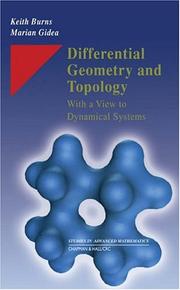
ISBN: 1584882530 9781584882534 Year: 2005 Publisher: Boca Raton Chapman & Hall
Abstract | Keywords | Export | Availability | Bookmark
 Loading...
Loading...Choose an application
- Reference Manager
- EndNote
- RefWorks (Direct export to RefWorks)
Differentiable dynamical systems. --- Differential topology. --- Geometry, Differential. --- Differentiable dynamical systems --- Differential topology --- Geometry, Differential --- 514.7 --- 515.1 --- Differential geometry --- Topology --- Differential dynamical systems --- Dynamical systems, Differentiable --- Dynamics, Differentiable --- Differential equations --- Global analysis (Mathematics) --- Topological dynamics --- 515.1 Topology --- 514.7 Differential geometry. Algebraic and analytic methods in geometry --- Differential geometry. Algebraic and analytic methods in geometry

ISBN: 1281905879 9786611905873 9812703519 9789812703514 9789812380425 9812380426 9812380426 9781281905871 6611905871 Year: 2005 Volume: v. 55 Publisher: New Jersey London World Scientific
Abstract | Keywords | Export | Availability | Bookmark
 Loading...
Loading...Choose an application
- Reference Manager
- EndNote
- RefWorks (Direct export to RefWorks)
This monograph presents a reasonably rigorous theory of a highly relevant chaos control method: suppression-enhancement of chaos by weak periodic excitations in low-dimensional, dissipative and non-autonomous systems. The theory provides analytical estimates of the ranges of parameters of the chaos-controlling excitation for suppression-enhancement of the initial chaos. The important applications of the theory presented in the book include: (1) control of chaotic escape from a potential well; (2) suppression of chaos in a driven Josephson junction; (3) control of chaotic solitons in Frenkel-Ko
Chaotic behavior in systems. --- Differentiable dynamical systems. --- Nonlinear control theory. --- Control theory --- Nonlinear theories --- Differential dynamical systems --- Dynamical systems, Differentiable --- Dynamics, Differentiable --- Differential equations --- Global analysis (Mathematics) --- Topological dynamics --- Chaos in systems --- Chaos theory --- Chaotic motion in systems --- Differentiable dynamical systems --- Dynamics --- System theory
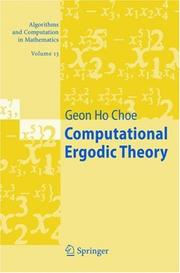
ISBN: 3540273050 3540231218 3642062075 Year: 2005 Publisher: Berlin, Heidelberg : Springer Berlin Heidelberg : Imprint: Springer,
Abstract | Keywords | Export | Availability | Bookmark
 Loading...
Loading...Choose an application
- Reference Manager
- EndNote
- RefWorks (Direct export to RefWorks)
Ergodic theory is hard to study because it is based on measure theory, which is a technically difficult subject to master for ordinary students, especially for physics majors. Many of the examples are introduced from a different perspective than in other books and theoretical ideas can be gradually absorbed while doing computer experiments. Theoretically less prepared students can appreciate the deep theorems by doing various simulations. The computer experiments are simple but they have close ties with theoretical implications. Even the researchers in the field can benefit by checking their conjectures, which might have been regarded as unrealistic to be programmed easily, against numerical output using some of the ideas in the book. One last remark: The last chapter explains the relation between entropy and data compression, which belongs to information theory and not to ergodic theory. It will help students to gain an understanding of the digital technology that has shaped the modern information society.
Ergodic theory. --- Ergodic theory --- Data processing. --- Mathematics. --- Dynamics. --- Physics. --- Applied mathematics. --- Engineering mathematics. --- Dynamical Systems and Ergodic Theory. --- Theoretical, Mathematical and Computational Physics. --- Appl.Mathematics/Computational Methods of Engineering. --- Ergodic transformations --- Continuous groups --- Mathematical physics --- Measure theory --- Transformations (Mathematics) --- Engineering --- Engineering analysis --- Mathematical analysis --- Natural philosophy --- Philosophy, Natural --- Physical sciences --- Dynamics --- Dynamical systems --- Kinetics --- Mathematics --- Mechanics, Analytic --- Force and energy --- Mechanics --- Physics --- Statics --- Math --- Science --- Differentiable dynamical systems. --- Mathematical and Computational Engineering. --- Differential dynamical systems --- Dynamical systems, Differentiable --- Dynamics, Differentiable --- Differential equations --- Global analysis (Mathematics) --- Topological dynamics --- Mathematical physics. --- Physical mathematics
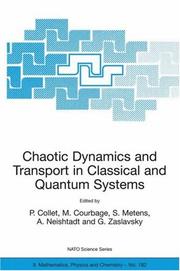
ISBN: 9786610190195 9781402029470 1280190191 1280263644 9786610263646 1402029470 1402029454 1402029462 9781402029462 9781402029479 Year: 2005 Volume: 182 Publisher: Dordrecht ; Boston : Kluwer,
Abstract | Keywords | Export | Availability | Bookmark
 Loading...
Loading...Choose an application
- Reference Manager
- EndNote
- RefWorks (Direct export to RefWorks)
From the 18th to the 30th August 2003 , a NATO Advanced Study Institute (ASI) was held in Cargèse, Corsica, France. Cargèse is a nice small village situated by the mediterranean sea and the Institut d'Etudes Scientifiques de Cargese provides ? a traditional place to organize Theoretical Physics Summer Schools and Workshops * in a closed and well equiped place. The ASI was an International Summer School on "Chaotic Dynamics and Transport in Classical and Quantum Systems". The main goal of the school was to develop the mutual interaction between Physics and Mathematics concerning statistical properties of classical and quantum dynamical systems. Various experimental and numerical observations have shown new phenomena of chaotic and anomalous transport, fractal structures, chaos in physics accelerators and in cooled atoms inside atom-optics billiards, space-time chaos, fluctuations far from equilibrium, quantum decoherence etc. New theoretical methods have been developed in order to modelize and to understand these phenomena (volume preserving and ergodic dynamical systems, non-equilibrium statistical dynamics, fractional kinetics, coupled maps, space-time entropy, quantum dissipative processes etc). The school gathered a team of specialists from several horizons lecturing and discussing on the achievements, perspectives and open problems (both fundamental and applied).
Chaotic behavior in systems --- Quantum theory --- Chaos --- Congresses. --- Congrès --- EPUB-LIV-FT LIVPHYSI SPRINGER-B --- Congresses --- Physics. --- Differentiable dynamical systems. --- Statistical physics. --- Physics, general. --- Dynamical Systems and Ergodic Theory. --- Complex Systems. --- Classical and Continuum Physics. --- Statistical Physics and Dynamical Systems. --- Physics --- Mathematical statistics --- Differential dynamical systems --- Dynamical systems, Differentiable --- Dynamics, Differentiable --- Differential equations --- Global analysis (Mathematics) --- Topological dynamics --- Natural philosophy --- Philosophy, Natural --- Physical sciences --- Dynamics --- Statistical methods --- Dynamics. --- Ergodic theory. --- Dynamical systems. --- Continuum physics. --- Classical field theory --- Continuum physics --- Continuum mechanics --- Dynamical systems --- Kinetics --- Mathematics --- Mechanics, Analytic --- Force and energy --- Mechanics --- Statics --- Ergodic transformations --- Continuous groups --- Mathematical physics --- Measure theory --- Transformations (Mathematics) --- Chaotic dynamics
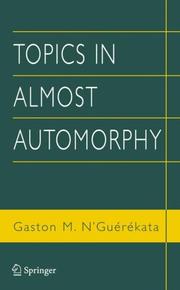
ISBN: 1280945044 9786610945047 0387274391 0387228462 1441935614 Year: 2005 Publisher: New York : Springer Science,
Abstract | Keywords | Export | Availability | Bookmark
 Loading...
Loading...Choose an application
- Reference Manager
- EndNote
- RefWorks (Direct export to RefWorks)
Since the publication of our first book [80], there has been a real resiu-gence of interest in the study of almost automorphic functions and their applications ([16, 17, 28, 29, 30, 31, 32, 40, 41, 42, 46, 51, 58, 74, 75, 77, 78, 79]). New methods (method of invariant s- spaces, uniform spectrum), and new concepts (almost periodicity and almost automorphy in fuzzy settings) have been introduced in the literature. The range of applications include at present linear and nonlinear evolution equations, integro-differential and functional-differential equations, dynamical systems, etc...It has become imperative to take a bearing of the main steps of the the ory. That is the main purpose of this monograph. It is intended to inform the reader and pave the road to more research in the field. It is not a self contained book. In fact, [80] remains the basic reference and fimdamental source of information on these topics. Chapter 1 is an introductory one. However, it contains also some recent contributions to the theory of almost automorphic functions in abstract spaces. VIII Preface Chapter 2 is devoted to the existence of almost automorphic solutions to some Unear and nonUnear evolution equations. It con tains many new results. Chapter 3 introduces to almost periodicity in fuzzy settings with applications to differential equations in fuzzy settings. It is based on a work by B. Bede and S. G. Gal [40].
Automorphic functions. --- Fuchsian functions --- Functions, Automorphic --- Functions, Fuchsian --- Functions of several complex variables --- Global analysis (Mathematics). --- Functional analysis. --- Fourier analysis. --- Differentiable dynamical systems. --- Differential equations, partial. --- Analysis. --- Functional Analysis. --- Fourier Analysis. --- Dynamical Systems and Ergodic Theory. --- Partial Differential Equations. --- Partial differential equations --- Differential dynamical systems --- Dynamical systems, Differentiable --- Dynamics, Differentiable --- Differential equations --- Global analysis (Mathematics) --- Topological dynamics --- Analysis, Fourier --- Mathematical analysis --- Functional calculus --- Calculus of variations --- Functional equations --- Integral equations --- Analysis, Global (Mathematics) --- Differential topology --- Functions of complex variables --- Geometry, Algebraic --- Mathematical analysis. --- Analysis (Mathematics). --- Dynamics. --- Ergodic theory. --- Partial differential equations. --- Ergodic transformations --- Continuous groups --- Mathematical physics --- Measure theory --- Transformations (Mathematics) --- Dynamical systems --- Kinetics --- Mathematics --- Mechanics, Analytic --- Force and energy --- Mechanics --- Physics --- Statics --- 517.1 Mathematical analysis --- Calculus. --- Analysis (Mathematics) --- Fluxions (Mathematics) --- Infinitesimal calculus --- Limits (Mathematics) --- Functions --- Geometry, Infinitesimal
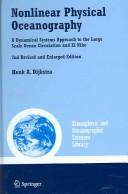
ISBN: 140202262X 1402022638 9786610956685 1280956682 9781402022630 9781402022623 Year: 2005 Volume: 28 Publisher: Dordrecht Springer Science+Business Media B.V.
Abstract | Keywords | Export | Availability | Bookmark
 Loading...
Loading...Choose an application
- Reference Manager
- EndNote
- RefWorks (Direct export to RefWorks)
In this book, methodology of dynamical systems theory is applied to investigate the physics of the large-scale ocean circulation. Topics include the dynamics of western boundary currents such as the Gulf Stream in the Atlantic Ocean and the Kurosio in the Pacific Ocean, the stability of the thermohaline circulation, and the El Niño/Southern Oscillation phenomenon in the Tropical Pacific. The book also deals with the numerical methods to apply bifurcation analysis on large-dimensional dynamical systems, with tens of thousands (or more) degrees of freedom, which arise through discretization of ocean and climate models. The novel approach to understand the phenomena of climate variability is through a systematic analysis of the solution structure of a hierarchy of models using these techniques. In this way, a connection between the results of the different models within the hierarchy can be established. Mechanistic description of the physics of the results is provided and, where possible, links with results of state-of-the-art ocean (and climate) models and observations are sought. The reader is expected to have a background in basic fluid dynamics and applied mathematics, although the level of the text sometimes is quite introductory. Each of the chapters is rather self-contained and many details of derivations are provided. Exercises presented at the end of each chapter make it a perfect graduate-level text. This book is aimed at graduate students and researchers in meteorology, oceanography and related fields who are interested in tackling fundamental problems in dynamical oceanography and climate dynamics.
Ocean circulation --- Differentiable dynamical systems. --- Mathematical models. --- El Niňo Current --- El Niño Current --- Oceanography. --- Electronic data processing. --- Climatology. --- Complex Systems. --- Numeric Computing. --- Atmospheric Sciences. --- Dynamical Systems and Ergodic Theory. --- ADP (Data processing) --- Automatic data processing --- Data processing --- EDP (Data processing) --- IDP (Data processing) --- Integrated data processing --- Computers --- Office practice --- Oceanography, Physical --- Oceanology --- Physical oceanography --- Thalassography --- Earth sciences --- Marine sciences --- Ocean --- Differential dynamical systems --- Dynamical systems, Differentiable --- Dynamics, Differentiable --- Differential equations --- Global analysis (Mathematics) --- Topological dynamics --- Automation --- Mathematical geography. --- Statistical physics. --- Dynamical systems. --- Numerical analysis. --- Atmospheric sciences. --- Dynamics. --- Ergodic theory. --- Ergodic transformations --- Continuous groups --- Mathematical physics --- Measure theory --- Transformations (Mathematics) --- Dynamical systems --- Kinetics --- Mathematics --- Mechanics, Analytic --- Force and energy --- Mechanics --- Physics --- Statics --- Atmospheric sciences --- Atmosphere --- Mathematical analysis --- Mathematical statistics --- Climate --- Climate science --- Climate sciences --- Science of climate --- Atmospheric science --- Statistical methods --- Corriente del Niño --- Holy Child Current --- Niño Current --- Ocean circulation - Mathematical models. --- El Niňo Current - Mathematical models.
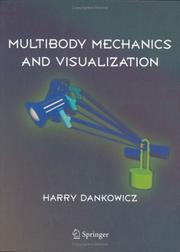
ISBN: 1846280680 1852337990 184996923X Year: 2005 Publisher: London : Springer London : Imprint: Springer,
Abstract | Keywords | Export | Availability | Bookmark
 Loading...
Loading...Choose an application
- Reference Manager
- EndNote
- RefWorks (Direct export to RefWorks)
Multibody Mechanics and Visualization is designed to appeal to computer-savvy students who will acquire significant skills in mathematical and physical modelling of mechanical systems in the process of producing attractive computer simulations and animations. The emphasis here is on general skills with all-round applicability rather than the ability to solve "cooked-up” problems. The approachable style and clear presentation of this text will help you grasp the essentials of: modeling the kinematics and dynamics of arbitrary multibody mechanisms; formulating a mathematical description of general motions of such mechanisms; implementing the description in a computer-graphics application for the animation/visualization of the movement. Multibody Mechanics and Visualization plays down the prediction of dynamics by formal analysis of differential equations while preparing its students to perform such analyses with greater understanding later. The text relies on the following principles for effective tuition: an inductive approach to learning - discerning general patterns from particular observations; repetition and review of important principles to reinforce your learning through numerous examples; obvious visual guidance that shows you at a glance which information you need for different levels of understanding; computer tools, visual representations and elements of active learning integrated into the text to suit the way you want to learn. Supported in the text in parallel with the theoretical presentation is the simulation and animation application Mambo. In contrast with existing commercially available educational software tools, Mambo requires detailed input from you in order to define the specific geometry of a mechanism as well as the differential equations governing its behavior while allowing you to visualize the results of your efforts. The Mambo toolbox enables you to provide these specifications for mechanisms that would pose insurmountable algebraic challenges to manual calculation. With these tools, you will be able to see the implications of decisions made throughout the modeling process, to check your mathematical analyses, and to enjoy the fruit of your labor! Mambo can be freely downloaded from the author's website and runs under any version of MS Windows®. The toolbox is compatible with the Maple™ software environment and the Matlab® extended symbolic toolbox.
Mechanics, Applied --- Computer simulation. --- Mathematical models. --- Mambo (Computer file) --- Applied mechanics --- Engineering, Mechanical --- Engineering mathematics --- Mechanical engineering. --- Engineering mathematics. --- Mechanics, applied. --- Differentiable dynamical systems. --- Computer aided design. --- Mechanics. --- Mechanical Engineering. --- Mathematical and Computational Engineering. --- Theoretical and Applied Mechanics. --- Dynamical Systems and Ergodic Theory. --- Computer-Aided Engineering (CAD, CAE) and Design. --- Classical Mechanics. --- Differential dynamical systems --- Dynamical systems, Differentiable --- Dynamics, Differentiable --- Differential equations --- Global analysis (Mathematics) --- Topological dynamics --- Engineering --- Engineering analysis --- Mathematical analysis --- Machinery --- Steam engineering --- CAD (Computer-aided design) --- Computer-assisted design --- Computer-aided engineering --- Design --- Classical mechanics --- Newtonian mechanics --- Physics --- Dynamics --- Quantum theory --- Mathematics --- Mechanics, Applied. --- Applied mathematics. --- Dynamics. --- Ergodic theory. --- Computer-aided engineering. --- CAE --- Ergodic transformations --- Continuous groups --- Mathematical physics --- Measure theory --- Transformations (Mathematics) --- Dynamical systems --- Kinetics --- Mechanics, Analytic --- Force and energy --- Mechanics --- Statics --- Data processing
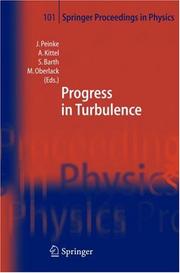
ISBN: 1280337613 9786610337613 3540274014 3540232168 3642062237 Year: 2005 Publisher: Berlin ; New York : Springer,
Abstract | Keywords | Export | Availability | Bookmark
 Loading...
Loading...Choose an application
- Reference Manager
- EndNote
- RefWorks (Direct export to RefWorks)
Besides turbulence there is hardly any other scientific topic which has been considered as a prominent scientific challenge for such a long time. The special interest in turbulence is not only based on it being a difficult scientific problem but also on its meaning in the technical world and our daily life. This carefully edited book comprises recent basic research as well as research related to the applications of turbulence. Therefore, both leading engineers and physicists working in the field of turbulence were invited to the iTi Conference on Turbulence held in Bad Zwischenahn, Germany 21st - 24th of September 2003. Discussed topics include, for example, scaling laws and intermittency, thermal convection, boundary layers at large Reynolds numbers, isotropic turbulence, stochastic processes, passive and active scalars, coherent structures, numerical simulations, and related subjects. .
Engineering. --- Dynamics. --- Ergodic theory. --- Partial differential equations. --- Fluids. --- Statistical physics. --- Dynamical systems. --- Vibration. --- Fluid mechanics. --- Engineering Fluid Dynamics. --- Vibration, Dynamical Systems, Control. --- Statistical Physics, Dynamical Systems and Complexity. --- Fluid- and Aerodynamics. --- Dynamical Systems and Ergodic Theory. --- Partial Differential Equations. --- Hydromechanics --- Continuum mechanics --- Cycles --- Mechanics --- Sound --- Dynamical systems --- Kinetics --- Mathematics --- Mechanics, Analytic --- Force and energy --- Physics --- Statics --- Mathematical statistics --- Hydraulics --- Hydrostatics --- Permeability --- Partial differential equations --- Ergodic transformations --- Continuous groups --- Mathematical physics --- Measure theory --- Transformations (Mathematics) --- Construction --- Industrial arts --- Technology --- Statistical methods --- Turbulence. --- Turbulence --- Mathematics. --- Flow, Turbulent --- Turbulent flow --- Fluid dynamics --- Hydraulic engineering. --- Differentiable dynamical systems. --- Differential equations, partial. --- Complex Systems. --- Differential dynamical systems --- Dynamical systems, Differentiable --- Dynamics, Differentiable --- Differential equations --- Global analysis (Mathematics) --- Topological dynamics --- Engineering, Hydraulic --- Engineering --- Fluid mechanics --- Shore protection
| Listing 1 - 10 of 19 | << page >> |
Sort by
|

 Search
Search Feedback
Feedback About UniCat
About UniCat  Help
Help News
News